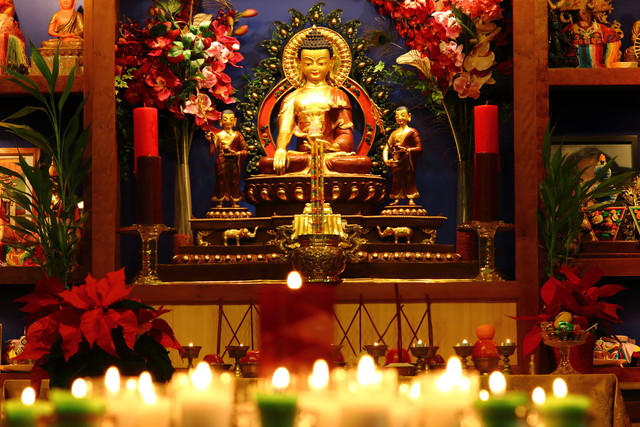First Time Visitors
 You Are Welcome Here!
You Are Welcome Here!
If you are a first time visitor to DGCEC, the first thing you will probably notice is the stunning entrance way to the building… this was created in a traditional Tibetan design that dates back many centuries.
On entering the building you will find a warm welcoming space that is again highly colored and yet profoundly peaceful. You may become aware that you are standing in a very unique space…. a sacred space!
Please note that as of June 2022 we require masks to be worn inside the center at all times. Thank you for respecting this compassion practice of "doing-no-harm" to others.
Shrine Room Etiquette
Visitors often ask the question: “How should I conduct myself properly in such a place”? Please consider the Temple a sacred area that is to be honored with respect.
Following are some of the guidelines to help you feel at ease and enjoy your visit.
- Please remove your shoes when you first enter the foyer area. Bare feet are acceptable.
- Put on your mask covering your nose and mouth. Forgot yours? We have some available.
- Please SILENCE your mobile phone, being aware that the “vibrate” setting can be heard by others. If possible, leave your phone with your shoes outside the shrine room.
- The typical greeting is to press both palms together at chest level and bow your head slightly. Often when greeting someone, Tibetans may grasp your hands in a handshake.
- If you are visiting when there is no formal service or meditation session then feel free to enter the shrine room and sit quietly. You are welcome to look around the space and enjoy the sacred artwork.
- We ask that you be mindful not to touch any of the objects in the altar area. If you enter the altar area to offer flowers or fruit, please keep in mind that the space is considered sacred, and show due respect.
- Please be mindful that whispering or texting during meditation or teachings is a distraction to others.
- Entering the shrine room you will notice both chairs and prayer cushions (zafus and zabutons) on the floor. You are welcome to sit on either.
- Please observe the Sacred Sand Mandala carefully, since it is constructed from loose sand and is very fragile. Do not touch the sand.
- Drinks in any kind of container do not belong in the shrine room. You may leave your tea in the gathering area for after meditation or the teaching.
Prayer and Meditation
All prayer and meditation sessions at DGCEC (unless otherwise announced) are open to everyone. You are welcome to join in regardless of your spiritual or religious background.
Though DGCEC is a Tibetan Buddhist Dharma center, our mission is intent on generating interfaith acceptance and dialogue under the guidance of His Holiness the Dalai Lama.
Wednesday Community Meditation lasts forty minutes, including chanting by the monks, and periods of silent meditation.
DGCEC prayer books are in English and the transliteration of the Tibetan chants so you can follow along and join in if you choose. We will not distribute prayer books at this time due to Covid-precautions.
We will resume the friendly visiting with tea and chatting after Covid has passed. At this time no tea or other beverages are allowed inside the Shrine Room or gathering area.
Saturday and Sunday Teachings
On Sundays Geshe Rapgyal-la offers the teaching in Tibetan followed by interpretation in English by Tenzin Namgyal (Tenam) who joins us via Zoom. You may join in-person with a mask. To get the Zoom link, please email [email protected].
Two Saturdays a month Geshe Rapgyal offers a Dharma talk in English. On the second Saturday this takes the form of a Dharma talk on a text, and on the fourth Saturday Geshe-la guides students in a practice.
Beginners or long-time students are welcome to register.
Sunday teachings, 10 - 11:30am, focus on a text by the Buddha or one of the great teachers. They begin with setting ones intention and a brief meditation and conclude with an opportunity for questions, additional prayers and a dedication of the practice.
Dharma Etiquette
Visitors to DGCEC often worry about proper behavior at the center. These are some general guidelines to respectful presence during a Dharma Talk or Meditation.
- Please arrive early as the teachings and prayer often begin slightly before the listed time. If you find yourself late, enter the shrine room quietly and be seated.
- You might find it comfortable to follow the other students when you arrive for a teaching or meditation session, observing their behavior.
- When Geshe-la enters the room and until he is seated, please stand as a sign of respect for the Dharma teacher. Often sangha members will prostrate out of humility and respect before the altar, teacher and sacred images. However, no one is required to prostrate.
- Visitors are welcome to sit as preferred, on either the zafu cushions or on chairs. Currently our seating is spread out as a Covid-precaution.
- Please wear comfortable but appropriate clothing for a prayer center.
- Be mindful of your posture and bear in mind that it is considered impolite to your feet outstretched towards the teacher or altar.
- Please do not place your prayer books or class materials directly on the floor but respect them as holders of the dharma and prayer.
- Please keep your questions at a reasonable length and hold them until the end of the teaching.
- Children are more than welcome to attend and are warmly welcomed by our Geshes. We ask that parents be attentive to their children’s needs - smaller children will find the sitting difficult - and be respectful of other participants during the teachings. We do not have childcare available nor a separate space for children to play.
